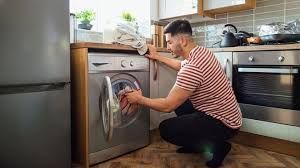Dryer Dilemmas: How to Identify, Fix, and Prevent Common Problems
any of us depend on the clothes dryer on a daily basis as household appliances. It's an essential component of contemporary living, whether it's folding clothes or fluffing up towels. But dryers might have problems that prevent them from working properly, just like any other device. You can save time, money, and frustration by learning how to recognize, address, and avoid common problems. In this thorough tutorial, we'll examine the most typical dryer problems and offer workable fixes to keep your device in good working order.
Identifying Common Problems:
It's critical to correctly diagnose the issue before taking any action about your dryer. Here are a few typical signs that your dryer isn't working properly:
- clothing Taking Longer to Dry: If your dryer is taking longer than usual to dry your clothing, it may be due to a malfunctioning thermostat, a clogged exhaust duct or vent, or a defective heating element.
- Overly Noisy: A dryer that makes strange noises, like screeching, grinding, or banging, may have worn-out bearings, damaged belts, or loose parts within.
- Failure to Start: A damaged belt, faulty door switch, or malfunctioning thermal fuse could be the cause of your dryer not starting when you click the power button.
- Overheating: A malfunctioning heating element, a broken thermostat, or restricted airflow can all contribute to an overheated dryer, which can be dangerous and could catch fire.
- Clothes Not Tumbling: If the drum in your dryer isn't spinning, it can be a result of a malfunctioning motor, a damaged drive belt, or worn-out roller wheels.
Fixing Common Problems:
You can take action to resolve your dryer's problem once you've located it. The following are some do-it-yourself dryer repair suggestions:
- Cleaning the Vent and Exhaust Duct: Keeping the vent and exhaust duct clean on a regular basis will help to increase airflow and reduce overheating. To clean the duct and vent of lint and debris, use a dryer vent brush or vacuum.
- Replacing the Heating Element: You might need to replace the heating element in your dryer if it isn't providing enough heat. For safe access to and replacement of the heating element, refer to the user handbook that came with your dryer.
- Oiling Moving Components: Your dryer's roller wheels or bearings may require maintenance if you hear any grinding or squealing sounds. To lower noise and friction, lubricate these parts with a tiny amount of high-temperature grease.
- Evaluating and Replacing Defective Parts: Make sure that parts like the thermostat, thermal fuse, and door switch are still operational by using a multimeter. To fix any malfunctioning parts and get your dryer working again, replace the defective parts with appropriate ones.
- Examining the Drive Belt: If the dryer's drum isn't spinning, check the drive belt for wear or damage. If the belt is loose or broken, replace it with a new one that fits the specifications of your dryer.
Preventing Future Problems:
To keep your dryer working longer and save money on repairs, prevention is essential. To maintain the best possible condition for your dryer, you can take the following preventive steps:
- To prevent lint buildup, enhance airflow, and lower the risk of fire, clean the lint filter by emptying it before or after each usage.
- Establish a Regular Maintenance Schedule: To inspect and clean internal components, check for wear and tear, and handle any possible concerns before they worsen, schedule yearly maintenance checks with a skilled expert.
- Avoid Overloading: Putting too much strain on your dryer's engine and other parts might cause premature wear and tear. To avoid damage and guarantee optimum operation, adhere to the manufacturer's load capacity requirements.
- Make Use of Proper Ventilation: To provide sufficient airflow and avoid overheating, make sure your dryer is properly aired. To reduce the risk of fire, keep the exhaust duct and vent free of debris and obstacles.
- As directed by the manufacturer: To guarantee safe and effective functioning, read and abide by the dryer's manufacturer's installation, operating, and maintenance instructions.
Longevity and Efficiency
It might be annoying to deal with dryer issues, but many can be found, resolved, and avoided with the correct information and resources. You may maintain a trouble-free dryer for many years to come by being aware of the typical signs of dryer issues, doing your own repairs, and taking preventative action.
Priority one should be given to correctly diagnosing the issue with your dryer. Correct diagnosis is the first step to a successful repair, whether the problem is weird noises, inconsistent heating, or inability to start. Once the issue has been identified, you may confidently move forward with fixing it.
Many common dryer problems can be solved affordably with do-it-yourself repair procedures. There are many easy fixes you can do on your own with basic tools and a little know-how, from cleaning vents and filters to replacing worn-out components. By doing these repairs yourself, you can avoid paying for expensive expert repairs and gain control over the upkeep of your appliances.
To keep your dryer operating at its best, preventive maintenance is essential. Common dryer issues can be avoided by doing necessary activities including routinely cleaning lint filters, inspecting vents for obstructions, and making sure there is enough airflow. Additionally, you can reduce internal component wear and tear by using the dryer in accordance with manufacturer guidelines and avoiding overloading it.
Working with electrical items should always put safety first. Take the necessary safety precautions and disconnect the power supply before starting any repairs or maintenance. Please don't hesitate to consult a competent professional if you have any questions regarding dryer repair or maintenance.
By taking good care of your dryer, you can keep dryer problems at bay and always have freshly laundered clothes available. Your dryer may be made to last longer, operate more efficiently, and provide dependable performance for many years to come with a little time and effort put into maintenance. Take proactive measures to keep your dryer in good working order and enjoy hassle-free laundry care. Don't let dryer troubles ruin your everyday routine.




